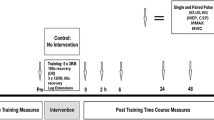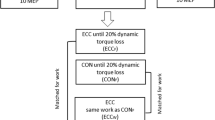Abstract
This study investigated the effects of 9-week endurance cycling training on central fatigability and corticomotor excitability of the locomotor muscles. Fourteen healthy participants undertook three incremental fatiguing cycling tests to volitional exhaustion (EXH): (i) before training (PRE), (ii) after training at the same absolute power output as PRE (POSTABS) and (iii) after training at the same percentage of V̇O2max as PRE (POSTREL). At baseline (i.e. before cycling), every 5 min during cycling and immediately at EXH, a neuromuscular evaluation including a series of 5-s knee extensions at 100, 75 and 50% of maximal voluntary knee extension (MVC) was performed. During each contraction, transcranial magnetic and peripheral nerve stimuli were elicited to obtain motor evoked potential (MEP), silent period (SP) and compound muscle action potential (Mmax) and to calculate voluntary activation (VA). The MEP·Mmax−1 ratio recorded from vastus lateralis at 100 and 50% MVC did not show any difference between conditions. At 75% MVC, MEP exhibited significantly lower values in POSTABS and POSTREL compared to PRE at baseline (P = 0.022 and P = 0.011, respectively) as well as at 25% of time to EXH of PRE (P = 0.022) for POSTREL. No adaptations, either at baseline or during cycling, were observed for VA and SPs. In conclusion, endurance training may result in some adaptations in the corticomotor responses when measured at rest or with low level of fatigue, yet these adaptations do not translate into attenuation of central fatigue at a similar cycling workload or at exhaustion.



Similar content being viewed by others
Abbreviations
- BF:
-
Biceps femoris
- CST:
-
Constant-load submaximal training
- Db100:
-
High-frequency doublet
- EMG:
-
Electromyography
- EXH:
-
Exhaustion
- HIIT:
-
High-intensity interval training
- HR:
-
Heart rate
- MEP:
-
Motor evoked potential
- MEP100, MEP75, MEP50 :
-
MEP·Mmax− 1 ratio (i.e. MEP is expressed as a % of Mmax recorded at 100, 75 and 50% of MVC, respectively)
- SP100, SP75, SP50 :
-
Silent period recorded at 100, 75 and 50% of MVC, respectively
- MVC:
-
Maximal voluntary contraction
- NMF:
-
Neuromuscular fatigue
- PNS:
-
Peripheral motor nerve stimulation
- POSTABS :
-
Fatigue session based on the same absolute power output as before training
- POSTREL :
-
Fatigue session based on the same relative intensity as before training
- PRE:
-
Initial fatigue test
- RMS:
-
Root mean square
- RMS100·Mmax100 − 1, RMS75·Mmax75 − 1 RMS50·Mmax50 − 1 :
-
Root mean square is expressed as a % of Mmax amplitude recorded at 100, 75 and 50% of MVC, respectively
- RPE:
-
Rate of perceived exertion
- SIT:
-
Superimposed twitch
- SP:
-
Silent period
- TMS:
-
Transcranial magnetic stimulation
- TTE:
-
Time to exhaustion
- VAPNS :
-
Voluntary activation (using peripheral nerve stimulation)
- VATMS :
-
Voluntary activation (using transcranial magnetic stimulation)
- VL:
-
Vastus lateralis
- \({\dot{{\rm V}}}\)O2max :
-
Maximal oxygen uptake
- \({\dot{{\rm V}}}\)O2peak :
-
Peak \({\dot{{\rm V}}}\)O2
- W max :
-
Maximal aerobic power output
References
Behrens M, Weippert M, Wassermann F, Bader R, Bruhn S, Mau-Moeller A (2015) Neuromuscular function and fatigue resistance of the plantar flexors following short-term cycling endurance training. Front Physiol 6:145. https://doi.org/10.3389/fphys.2015.00145
Carroll TJ, Riek S, Carson RG (2002) The sites of neural adaptation induced by resistance training in humans. J Physiol 15(544):641–652
Carroll TJ, Barton J, Hsu M, Lee M (2009) The effect of strength training on the force of twitches evoked by corticospinal stimulation in humans. Acta Physiol 197(2):161–173. https://doi.org/10.1111/j.1748-1716.2009.01992.x
Daussin FN, Zoll J, Dufour SP, Ponsot E, Lonsdorfer-Wolf E, Doutreleau S, Mettauer B, Piquard F, Geny B, Richard R (2008) Effect of interval versus continuous training on cardiorespiratory and mitochondrial functions: relationship to aerobic performance improvements in sedentary subjects. Am J Physiol Regul Integr Comp Physiol 295(1):R264–R272. https://doi.org/10.1152/ajpregu.00875.2007
Doyle-Baker D, Temesi J, Medysky ME, Holash RJ, Millet GY (2018) An innovative ergometer to measure neuromuscular fatigue immediately after cycling. Med Sci Sports Exerc 50(2):375–387. https://doi.org/10.1249/MSS.0000000000001427
Edge J, Bishop D, Goodman C (2006) The effects of training intensity on muscle buffer capacity in females. Eur J Appl Physiol 96:97–105. https://doi.org/10.1007/s00421-005-0068-6
Falvo MJ, Sirevaag EJ, Rohrbaugh JW, Earhart GM (2010) Resistance training induces supraspinal adaptations: evidence from movement-related cortical potentials. Eur J Appl Physiol 109(5):923–933. https://doi.org/10.1007/s00421-010-1432-8
Gandevia SC, Allen GM, Butler JE, Taylor JL (1996) Supraspinal factors in human muscle fatigue: evidence for suboptimal output from the motor cortex. J Physiol 15(490):529–536
Gandevia SC, Petersen N, Butler JE, Taylor JL (1999) Impaired response of human motoneurones to corticospinal stimulation after voluntary exercise. J Physiol 15:749–759
Goodall S, González-Alonso J, Ali L, Ross EZ, Romer LM (2012) Supraspinal fatigue after normoxic and hypoxic exercise in humans. J Physiol 590(11):2767–2782. https://doi.org/10.1113/jphysiol.2012.228890
Gruet M, Temesi J, Rupp T, Levy P, Millet GY, Verges S (2013) Stimulation of the motor cortex and corticospinal tract to assess human muscle fatigue. Neuroscience 12(231):384–399. https://doi.org/10.1016/j.neuroscience.2012.10.058
Gunnarsson TP, Christensen PM, Thomassen M et al (2013) Effect of intensified training on muscle ion kinetics, fatigue development, and repeated short-term performance in endurance-trained cyclists. AJP Regul Integr Comp Physiol 305:R811–R821. https://doi.org/10.1152/ajpregu.00467.2012
Hunter SK, Todd G, Butler JE, Gandevia SC, Taylor JL (2008) Recovery from supraspinal fatigue is slowed in old adults after fatiguing maximal isometric contractions. J Appl Physiol 105(4):1199–1209. https://doi.org/10.1152/japplphysiol.01246.2007
Jensen JL, Marstrand PC, Nielsen JB (2005) Motor skill training and strength training are associated with different plastic changes in the central nervous system. J Appl Physiol 99(4):1558–1568
Jones AM, Carter H (2000) The effect of endurance training on parameters of aerobic fitness. Sports Med 29(6):373–386
Jubeau M, Rupp T, Perrey S, Temesi J, Wuyam B, Levy P, Verges S, Millet GY (2014) Changes in voluntary activation assessed by transcranial magnetic stimulation during prolonged cycling exercise. PLoS One 21 9(2):e89157. https://doi.org/10.1371/journal.pone.0089157
Laursen PB, Jenkins DG (2002) The scientific basis for high-intensity interval training: optimising training programmes and maximising performance in highly trained endurance athletes. Sports Med 32:53–73. https://doi.org/10.2165/00007256-200232010-00003
Le Pera D, Graven-Nielsen T, Valeriani M, Oliviero A, Di Lazzaro V, Tonali PA, Arendt-Nielsen L (2001) Inhibition of motor system excitability at cortical and spinal level by tonic muscle pain. Clin Neurophysiol 112(9):1633–1641
Mira J, Lapole T, Souron R, Messonnier L, Millet GY, Rupp T (2017) Cortical voluntary activation testing methodology impacts central fatigue. Eur J Appl Physiol 117(9):1845–1857. https://doi.org/10.1007/s00421-017-3678-x
Murias JM, Kowalchuk JM, Paterson DH (2010a) Speeding of V̇O2 kinetics with endurance training in old and young men is associated with improved matching of local O2 delivery to muscle O2 utilization. J Appl Physiol 108(4):913–922. https://doi.org/10.1152/japplphysiol.01355.2009
Murias JM, Kowalchuk JM, Paterson DH (2010b) Time course and mechanisms of adaptations in cardiorespiratory fitness with endurance training in older and young men. J Appl Physiol 108(3):621–627. https://doi.org/10.1152/japplphysiol.01152.2009
Murias JM, Kowalchuk JM, Ritchie D, Hepple RT, Doherty TJ, Paterson DH (2011) Adaptations in capillarization and citrate synthase activity in response to endurance training in older and young men. J Gerontol A Biol Sci Med Sci 66(9):957–964. https://doi.org/10.1093/gerona/glr096
Nybo L, Secher NH (2004) Cerebral perturbations provoked by prolonged exercise. Prog Neurobiol 72:223–261
O’Leary TJ, Collett J, Howells K, Morris MG (2017) Endurance capacity and neuromuscular fatigue following high vs moderate-intensity endurance training: a randomised trial. Scand J Med 27(12):1648–1661. https://doi.org/10.1111/sms.12854
Perot C, Goubel F, Mora I (1991) Quantification of T- and H-responses before and after a period of endurance training. Eur J Appl Physiol 63:368–375
Rossi S, Hallett M, Rossini PM, Pascual-Leone A (2011) Screening questionnaire before TMS: an update. Clin Neurophysiol 122(8):1686. https://doi.org/10.1016/j.clinph.2010.12.037
Schnitzler A, Benecke R (1994) The silent period after transcranial magnetic stimulation is of exclusive cortical origin: evidence from isolated cortical ischemic lesions in man. Neurosci Lett 180(1):41–45
Sidhu SK, Bentley DJ, Carroll TJ (2009) Locomotor exercise induces long-lasting impairments in the capacity of the human motor cortex to voluntarily activate knee extensor muscles. J Appl Physiol 106(2):556–565. https://doi.org/10.1152/japplphysiol.90911.2008
Sidhu SK, Weavil JC, Mangum TS, Jessop JE, Richardson RS, Morgan DE, Amann M (2017) Group III/IV locomotor muscle afferents alter motor cortical and corticospinal excitability and promote central fatigue during cycling exercise. Clin Neurophysiol 128(1):44–55. https://doi.org/10.1016/j.clinph.2016.10.008
Sinoway L (1996) Neural responses to exercise in humans: implications for congestive heart failure. Clin Exp Pharmacol Physiol 23(8):693–699
Strojnik V, Komi PV (1998) Neuromuscular fatigue after maximal stretch-shortening cycle exercise. J Appl Physiol 84(1):344–350
Svensson P, Miles TS, McKay D, Ridding MC (2003) Suppression of motor evoked potentials in a hand muscle following prolonged painful stimulation. Eur J Pain 7(1):55–62
Taylor JL, Petersen NT, Butler JE, Gandevia SC (2002) Interaction of transcranial magnetic stimulation and electrical transmastoid stimulation in human subjects. J Physiol 15:949–958
Taylor JL, Todd G, Gandevia SC (2006) Evidence for a supraspinal contribution to human muscle fatigue. Clin Exp Pharmacol Physiol 33(4):400–405
Taylor JL, Amann M, Duchateau J, Meeusen R, Rice CL (2016) Neural contributions to muscle fatigue: from the brain to the muscle and back again. Med Sci Sports Exerc 48(11):2294–2306
Temesi J, Rupp T, Martin V, Arnal PJ, Féasson L, Verges S, Millet GY (2014) Central fatigue assessed by transcranial magnetic stimulation in ultratrail running. Med Sci Sports Exerc 46(6):1166–1175. https://doi.org/10.1249/MSS.0000000000000207
Todd G, Taylor JL, Gandevia SC (2003) Measurement of voluntary activation of fresh and fatigued human muscles using transcranial magnetic stimulation. J Physiol 551:661–671
Todd G, Taylor JL, Gandevia SC (2004) Reproducible measurement of voluntary activation of human elbow flexors with motor cortical stimulation. J Appl Physiol 97:236–242
Warburton DER, Haykowsky MJ, Quinney HA et al (2004) Blood volume expansion and cardiorespiratory function: effects of training modality. Med Sci Sports Exerc 36:991–1000. https://doi.org/10.1249/01.MSS.0000128163.88298
Weavil JC, Sidhu SK, Mangum TS, Richardson RS, Amann M (2016) Fatigue diminishes motoneuronal excitability during cycling exercise. J Neurophysiol 116(4):1743–1751. https://doi.org/10.1152/jn.00300.2016
Zghal F, Cottin F, Kenoun I, Rebaï H, Moalla W, Dogui M, Tabka Z, Martin V (2015) Improved tolerance of peripheral fatigue by the central nervous system after endurance training. Eur J Appl Physiol 115(7):1401–1415. https://doi.org/10.1007/s00421-015-3123-y
Acknowledgements
Saied Jalal Aboodarda was funded by the Eyes High Postdoctoral Scholars. This study was also supported by the Université Savoie Mont Blanc as part of the doctoral work of José Mira.
Author information
Authors and Affiliations
Contributions
TR, GYM, SJA, and JM conceived and designed the research. SJA, JM, MF, RJ, SJM, and KA conducted the experiment and analyzed data. SJA wrote the manuscript. All authors read and approved the manuscript.
Corresponding author
Additional information
Communicated by Phillip D Chilibeck.
Rights and permissions
About this article
Cite this article
Aboodarda, S.J., Mira, J., Floreani, M. et al. Effects of endurance cycling training on neuromuscular fatigue in healthy active men. Part II: Corticospinal excitability and voluntary activation. Eur J Appl Physiol 118, 2295–2305 (2018). https://doi.org/10.1007/s00421-018-3951-7
Received:
Accepted:
Published:
Issue Date:
DOI: https://doi.org/10.1007/s00421-018-3951-7




